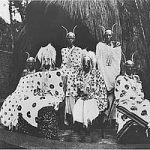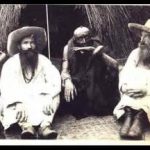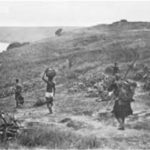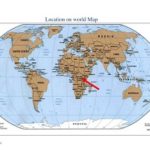V. Land Tenure And Use
Land tenure is a very delicate subject to handle in the historical circumstances that surround land holdings in Remera. First, it must be remembered that no such thing as private property in land existed under customary law, at least not as defined in our own society. We might say that “private property” of land estates, in our terms, was instituted by the Belgian administration in this part of Ruanda about 1958.
The right to occupy an unused part of the area is granted by the chieftain. This right cannot be taken away, although there are ways of causing individuals to abandon it. Long established families in the area, however, have usually accumulated considerable land that is administrated within the lineage by the head of the lineage. Moreover, it seems that although there are no precise true limits to the holding of unused land, a lineage keeps rights over land it has only recently left fallow, so that it can contest occupancy by a strange party, even if this party has been allotted the land by the chieftain. The lineage has to contest; however, if it means to keep its rights in the land, otherwise it loses them.
The lineage can “lend” its rights to a third party, in which case care is taken not to let the borrower plant a banana plantation, or, in more recent times, plant coffee, or build a “permanent” house on it, because, by making permanent improvements, the borrower establishes continuing rights to the land.
New lands can be opened and added to a lineage’s holdings; other parts can be abandoned by it — in which case they become inkungu, i.e., they come again under the authority of the chieftain, who can “give” them away.
Rights over land are inherited from the lineage. The lineage head and the land handle distribution within the lineage and the land reserved for redistribution within the lineage is called ingarigari.
A man, however, may be an immigrant from another Hill.In this case, the chieftain can give himinkungu holdings, that is, land, or a banana or coffee plantation left in the case of the chieftain for redistribution. This may be simply land abandoned by someone leaving for another Hill, or it may have been given deliberately to the chieftain by someone who felt he had no further use for it. This may occur, for instance, with a man whose sons are all provided for and he has become too old to take case of his own plantations, or with a person who has no heir.
In the case of an inkungu banana or coffee plantation, the rights are usually transferred to the third party who acquires these rights with no prejudice; he cannot subsequently be dispossessed. His rights over the plants overrule the rights of the lineage over the use of the land upon winch the plants are grown. This has led to misinterpretation of customary law by the administration, especially in more recent times.
Lands which can be allocated to anyone, and to which no individual or lineage rights are attached are in ishyamba (pl. amashyamba), i.e., the bush although the word is usually translated as “forest”, it actually refers to any uncultivated lands with or without trees — on hills, or in the marshes. Umukenkeis wild land that has never been cultivated, and ikyibirarefers to wild land with bushes. In order to occupy these lands, only the permission of the chieftain is necessary. They are usually lands that are isolated, inferior, or that have to be broken for cultivation.
Areas, which are completely uninhabited and are uninhabitable for any reason, are called kidaturwa. Monsieur Sandrart (Georges Sandrart, Cours de droit coutumier du Ruanda (Astrida, Groupe Scholaire d’Astrida, 1939)says that this refers to a hill uninhabited because of bad luck, but, this is not the connotation in Remera. Such areas are usually part of a chiefdom.
Under the new circumstances, land holdings have been frozen, so to speak. However, the forms of land tenure just described are basic; they existed in traditional times and still formed thesubstantial pattern at the time just before the elections of July 1960.
It may be noted that this is the pattern found in tribal chieftainships. It is also worthy of notice that, with the breakdown of the feudal superstructure of land tenure, land tenure has lately reverted to this tribal pattern.
Nevertheless, a feudal structure had been built over this basic pattern and had modified it largely. Rights over land became more complex because different rights superimposed themselves upon one another within the same holdings. For instance, one man may have had the right to the produce of the parcel of land, but another had the right to the first fruit from it, and still another had the right to pasture his cows on it. These rights were by their nature overlapping, particularly the first with the other two, and therefore sources of conflict. The limits of each individual household’s rights, therefore, depended on its head’s feudo-political power.
European scholars of Ruanda have generally seen the cow as the sole beneficeand completely distinct from land tenure. The cow is also regarded by them as the cause of service. The present author disagrees. The benefice, land, was the measure of service and the cow recorded the grant of benefice. As in continental Europe of the ninth century, according to Monsieur François Louis Ganshof, the benefice was still the measure and almost the condition of service, although later it became the cause.
Summit lands are by far the preferred lands, although they are not necessarily the most fertile. They are preferred because communication is much easier on the summits than between valleys or between a summit and valley. In addition, the chieftain lives on the summit.
The average land holding is 241,156 square feet, or 5.5 acres. Of this, 119,989 square feet, or 2.71 acres are used in one way or another for agricultural production. These figures are in accord with Monsieur Pierre Gourou’s estimate of 1.02 hectares, or about 2.5 acres for the Territory of Kibungu.He gives a family size of 4.7 persons per household for the Territory of Kibungu. For the type of social and technological development that is found in Remera, this seems normal. These figures may be compared also with those given from various sources by Dr. Philippe Leurquin for a number of comparable areas of the world, where hoe cultivation is found.He suggests here and elsewhere,that it is not shortage of land that limits production, but the physical limitations imposed by the “stagnant” technology.
The average area cultivated per person in Remera is 18,508 square feet, or less than one-half acres. It must be noted that the mean number of peasants per household is higher than the average for the Hill as a whole, but the median is closer.
Bananas represent the largest area planted by the average household, occupying 42,279.8 square feet, or 36.39% of the area used. However, it is to be noted that it is not the largest area in all of the individual holdings included in the s ample. Beans follow in the size of the area given to their cultivation, and then maize.
These figures are taken from a sample of land holdings as they appeared at the time of the investigation in Remera. The sample is not random, but, on the other hand, it is not deliberately oriented. All six “properties” are situated on the summit with the exception of two banana plantations which make up a part of the holdings of Gasingwa and Rwibuka and are situated in the lowlands.
https://uk.amateka.net/v-land-tenure-and-use/https://uk.amateka.net/wp-content/uploads/2021/04/landscape.jpghttps://uk.amateka.net/wp-content/uploads/2021/04/landscape-150x150.jpgModel CitizenshipLand tenure is a very delicate subject to handle in the historical circumstances that surround land holdings in Remera. First, it must be remembered that no such thing as private property in land existed under customary law, at least not as defined in our own society. We might say...BarataBarata rpierre@ikaze.netAdministratorAMATEKA | HISTORY OF RWANDA




